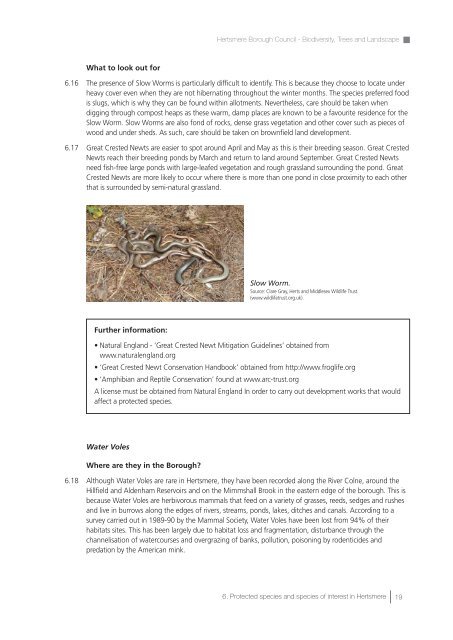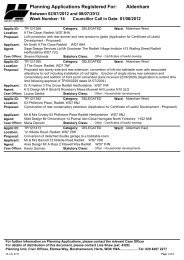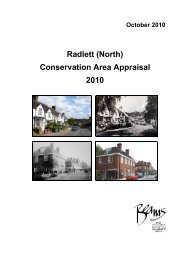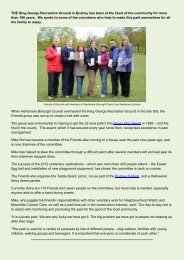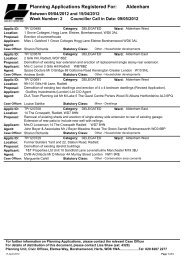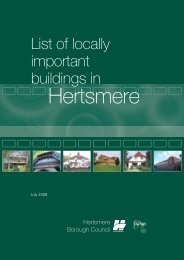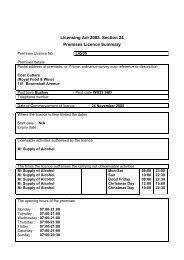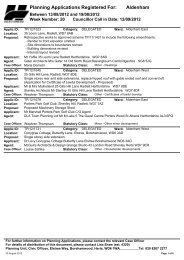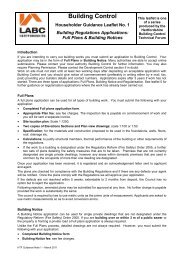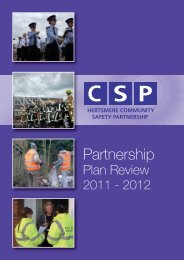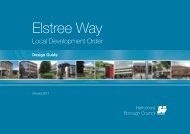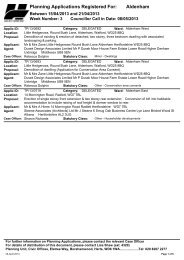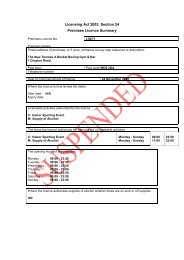Biodiversity - Hertsmere Borough Council
Biodiversity - Hertsmere Borough Council
Biodiversity - Hertsmere Borough Council
Create successful ePaper yourself
Turn your PDF publications into a flip-book with our unique Google optimized e-Paper software.
<strong>Hertsmere</strong> <strong>Borough</strong> <strong>Council</strong> - <strong>Biodiversity</strong>, Trees and Landscape<br />
What to look out for<br />
6.16 The presence of Slow Worms is particularly difficult to identify. This is because they choose to locate under<br />
heavy cover even when they are not hibernating throughout the winter months. The species preferred food<br />
is slugs, which is why they can be found within allotments. Nevertheless, care should be taken when<br />
digging through compost heaps as these warm, damp places are known to be a favourite residence for the<br />
Slow Worm. Slow Worms are also fond of rocks, dense grass vegetation and other cover such as pieces of<br />
wood and under sheds. As such, care should be taken on brownfield land development.<br />
6.17 Great Crested Newts are easier to spot around April and May as this is their breeding season. Great Crested<br />
Newts reach their breeding ponds by March and return to land around September. Great Crested Newts<br />
need fish-free large ponds with large-leafed vegetation and rough grassland surrounding the pond. Great<br />
Crested Newts are more likely to occur where there is more than one pond in close proximity to each other<br />
that is surrounded by semi-natural grassland.<br />
Slow Worm.<br />
Source: Clare Gray, Herts and Middlesex Wildlife Trust.<br />
(www.wildlifetrust.org.uk).<br />
Further information:<br />
• Natural England - ‘Great Crested Newt Mitigation Guidelines’ obtained from<br />
www.naturalengland.org<br />
• ‘Great Crested Newt Conservation Handbook’ obtained from http://www.froglife.org<br />
• ‘Amphibian and Reptile Conservation’ found at www.arc-trust.org<br />
A license must be obtained from Natural England In order to carry out development works that would<br />
affect a protected species.<br />
Water Voles<br />
Where are they in the <strong>Borough</strong><br />
6.18 Although Water Voles are rare in <strong>Hertsmere</strong>, they have been recorded along the River Colne, around the<br />
Hillfield and Aldenham Reservoirs and on the Mimmshall Brook in the eastern edge of the borough. This is<br />
because Water Voles are herbivorous mammals that feed on a variety of grasses, reeds, sedges and rushes<br />
and live in burrows along the edges of rivers, streams, ponds, lakes, ditches and canals. According to a<br />
survey carried out in 1989-90 by the Mammal Society, Water Voles have been lost from 94% of their<br />
habitats sites. This has been largely due to habitat loss and fragmentation, disturbance through the<br />
channelisation of watercourses and overgrazing of banks, pollution, poisoning by rodenticides and<br />
predation by the American mink.<br />
6. Protected species and species of interest in <strong>Hertsmere</strong> 19


